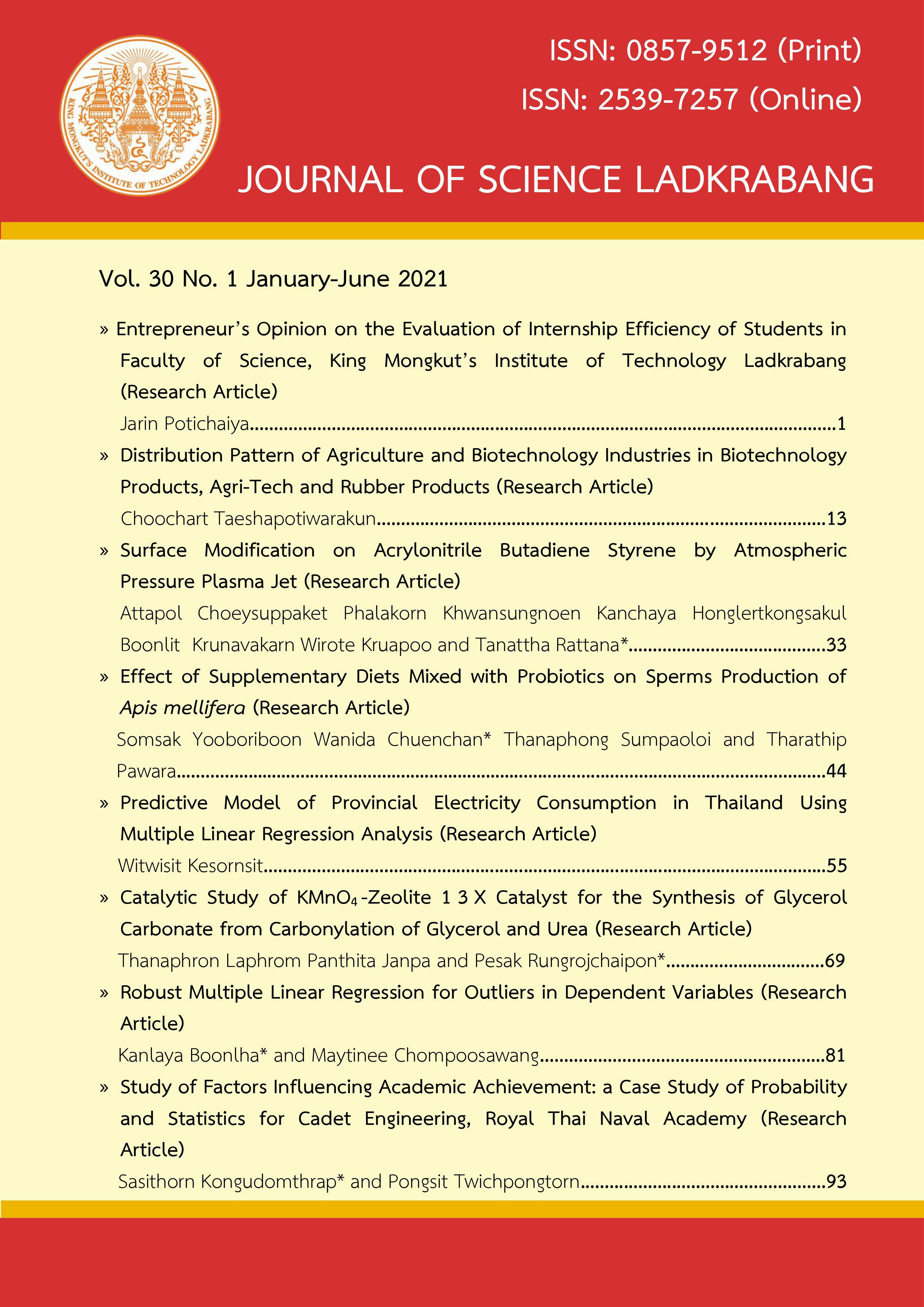Predictive Model of Provincial Electricity Consumption in Thailand Using Multiple Linear Regression Analysis
Main Article Content
Abstract
The aims of this research were to study the effecting factor in the provincial electricity consumption in Thailand and to construct the model for accurate prediction of provincial electricity consumption by using multiple linear regression analysis. The data used in this research is the secondary data from related agency open data. There are 5 dimensions that are used in model development consists of 1) electricity usage profiles, 2) topography, 3) weather atmosphere, 4) industrial information, and 5) household information. The programming language and free software environment for statistical computing is used to analyze and develop the predictive model. The results showed that the statistically significant effecting factors in provincial electricity consumption are 11 factors. Additionally, the most suitable effecting dimensions were in the weather atmosphere and industrial information, which was to have 3 factors. The second suitable effecting dimensions were in topography and household information, which was to have 2 factors. Moreover, the dimension in electricity usage profiles was affected the electricity consumption only one factor. The developed model is fit to the empirical data with R-Square in 95.13 percentage and Adjusted R-squared in 95.04 percentage. The accuracy of the model is 95.13 percentage. Finally, the multiple linear regression model is based on several key assumptions of that are fitted and did not the sample data problem.
Article Details
References
ภัทรภรณ์ หิรัญวงศ์ และสิงหพันธุ์ สิงหเสนี. 2015. อนาคตพลังงานไฟฟ้าไทยพอเพียงแต่เสี่ยงภัย, Focused and Quick (FAQ) Bank of Thailand, 102, 1-7 [Pattharaporn Hirunwong and Singhapan Singhaseni. 2015. The future of Thai electricity is self-sufficient, but risky, Focused and Quick (FAQ) Bank of Thailand, 102, 1-7. (in Thai)]
เผด็จ ไชยมงคล, วิชัย สุระพัฒน์, และคมสันต์ หงษ์สมบัติ. 2557. การจัดการพลังงานไฟฟ้าในระบบจำหน่ายแบบสมาร์ทกริดอย่างมีประสิทธิภาพ. วิศวกรรมสาร มก., 27(88), 81-92. [Phadet Chaimongkol, Wichai Surapat, and Khomsan Hongsombat. 2014. Effective Energy Management in Smart Grid Distribution System. Kasetsart Engineering Journal, 27(88), 81-92. (in Thai)]
นิฉา แก้วหาวงษ์. 2558. การพยากรณ์ปริมาณการใช้ไฟฟ้าของประเทศไทยโดยใช้ตัวแบบ SARIMA และตัวแบบการถดถอยที่มีความคลาดเคลื่อนเป็นตัวแบบ ARMA. วารสารวิทยาศาสตร์และเทคโนโลยี, 4(1), 24-36. [Nicha Kaewhawong. 2015. Forecasting Electricity Consumption of Thailand by Using SARIMA and Regression Models with ARMA Errors). Thai Journal of Science and Technology, 4(1), 24-36. (in Thai)]
ปรีดาภรณ์ กาญจนสำราญวงศ์ และสุฑารัตน์ ทองรอง. 2555. ตัวแบบพยากรณ์ปริมาณการใช้ไฟฟ้าของการไฟฟ้าส่วนภูมิภาค เขต 2 ภาคใต้. วารสารวิทยาศาสตร์ มศว, 28(2), 13-29. [Preedaporn Kanjanasamranwong and Sutarat Thongrong. 2012. Forecasting Model in Electrical Power Consumption of the Provincial Electricity Authority in Southern Area 2. Srinakharinwirot Science Journal, 28(2), 13-29. (in Thai)]
ประกาศ เรื่อง ยุทธศาสตร์ชาติ (พ.ศ. 2561 - 2580). 2018. (2561, 13 ตุลาคม). ราชกิจจานุเบกษา. เล่มที่ 135. [The National Strategy Act B.E. 2561 - 2580 (2018 - 2037C.E.). 2018. (2561, 13 October). Royal Thai Government Gazette. Volume 135. (in Thai)]
Kipping, A. and Trømborg, E. 2015. Hourly electricity consumption in Norwegian households–Assessing the impacts of different heating systems. Energy, 93, 655-671.
Kavousian, A., Rajagopal, R. and Fischer, M.J.E. 2013. Determinants of residential electricity consumption: Using smart meter data to examine the effect of climate, building characteristics, appliance stock, and occupants' behavior. Energy, 55, 184-194.
Lin, B. and Ouyang, X. 2014. Electricity demand and conservation potential in the Chinese nonmetallic mineral products industry. Energy Policy, 68, 243-253.
Zhou, K., Yang, S. and Shao, Z. 2017. Household monthly electricity consumption pattern mining: A fuzzy clustering-based model and a case study. Journal of cleaner production, 141, 900-908.
สำนักงานพัฒนารัฐบาลดิจิทัล. 2563. ศูนย์กลางข้อมูลเปิดภาครัฐ (Open Government Data). สำนักนายกรัฐมนตรี, แหล่งข้อมูล: https://data.go.th. ค้นเมื่อวันที่ 23 ตุลาคม 2563.
สำนักงานสถิติแห่งชาติ. 2563. สถิติผู้ใช้น้ำ ปริมาณการผลิต และการจำหน่ายน้ำประปา ปีงบประมาณ 2549 - 2558 สถิติผู้ใช้ไฟฟ้า และการจำหน่ายพลังงานไฟฟ้า จำแนกตามประเภทผู้ใช้ พ.ศ. 2549 - 2558. แหล่งข้อมูล: https://data.go.th/dataset/statseries18. ค้นเมื่อวันที่ 23 ตุลาคม 2563.
สำนักงานสถิติแห่งชาติ. 2562. สถิติประชากรศาสตร์ ประชากรและเคหะ. แหล่งข้อมูล: http:// statbbi.nso.go.th/staticreport/page/sector/th/01.aspx. ค้นเมื่อวันที่ 23 ตุลาคม 2563.
กรมอุตุนิยมวิทยา. 2561. รายงานค่าสถิติภูมิอากาศ ค่าปกติ ประเทศไทย 2524-2553. แหล่งข้อมูล: https://data.tmd.go.th/api/index1.php. ค้นเมื่อวันที่ 23 ตุลาคม 2563.
สำนักงานสถิติแห่งชาติ. 2557. สถิติโรงงานอุตสาหกรรม ที่จดทะเบียนไว้กับกระทรวงอุตสาหกรรม และได้รับอนุญาตให้ประกอบกิจการ (ตามพระราชบัญญัติโรงงาน พ.ศ. 2535) พ.ศ. 2548 - 2557. แหล่งข้อมูล: http://service.nso.go.th/nso/web/statseries/statseries16.html. ค้นเมื่อวันที่ 23 ตุลาคม 2563.
สำนักงานสถิติแห่งชาติ. 2558. รายได้เฉลี่ยต่อเดือนต่อครัวเรือน จำแนกตามภาค และจังหวัด พ.ศ. 2541 - 2558. แหล่งข้อมูล: http://service.nso.go.th/nso/web/statseries/statseries11.html. ค้นเมื่อวันที่ 23 ตุลาคม 2563.
จิราวัลย์ จิตรถเวช. 2558. การวิเคราะห์การถดถอย. พิมพ์ครั้งที่ 1, โครงการส่งเสริมและพัฒนาเอกสารวิชาการ, กรุงเทพมหานคร. [Jirawan Jitthavech. 2015. Regression Analysis. 1st ed. National Institute of Development Administration, Bangkok. (in Thai)]
Aiken, L.S., West, S.G., Pitts, S.C., Baraldi, A.N. and Wurpts, I.C. 2012. Multiple linear regression. Handbook of Psychology. 2nd ed.
Seber, G.A.F. and Lee, A.J. 2012. Linear regression analysis (Vol. 329): John Wiley & Sons.
Ghorbani, H. 2019. Mahalanobis distance and its application for detecting multivariate outliers. Facta Univ Ser Math Inform, 34(3), 583-95.
Stevens, J.P. 1984. Outliers and influential data points in regression analysis. Psychological bulletin, 95(2), 334.
Savin, N.E. and White, K.J. 1977. The Durbin-Watson test for serial correlation with extreme sample sizes or many regressors. Econometrica, 1989-1996.
Mansfield, E.R. and Helms, B.P. 1982. Detecting multicollinearity. The American Statistician, 36(3a), 158-160.
Craney, T.A. and Surles, J.G. 2002. Model-dependent variance inflation factor cutoff values. Quality Engineering, 14(3), 391-403.
Berk, K.N. 1977. Tolerance and condition in regression computations. Journal of the American Statistical Association, 72(360), 863-866.
Quesenberry, C.P. and Quesenberry Jr, C. 1982. On the distribution of residuals form fitted parametric models. Journal of Statistical Computation and Simulation, 15(2-3), 129-140.
Waldman, D.M. 1983. A note on algebraic equivalence of White's test and a variation of the Godfrey/Breusch-Pagan test for heteroscedasticity. Economics Letters, 13(2-3), 197-200.
Li, Y., Pizer, W. A. and Wu, L. 2019. Climate change and residential electricity consumption in the Yangtze River Delta, China. Proceedings of the National Academy of Sciences, 116(2), 472-477.
Yu, M., Zhao, X. and Gao, Y. 2019. Factor decomposition of China’s industrial electricity consumption using structural decomposition analysis. Structural Change and Economic Dynamics, 51, 67-76.

